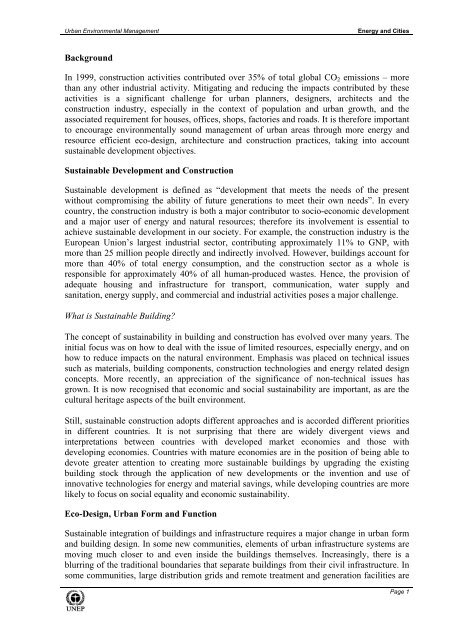Energy and Cities - International Environmental Technology Centre
Energy and Cities - International Environmental Technology Centre
Energy and Cities - International Environmental Technology Centre
Create successful ePaper yourself
Turn your PDF publications into a flip-book with our unique Google optimized e-Paper software.
Urban <strong>Environmental</strong> Management<br />
<strong>Energy</strong> <strong>and</strong> <strong>Cities</strong><br />
Background<br />
In 1999, construction activities contributed over 35% of total global CO 2 emissions – more<br />
than any other industrial activity. Mitigating <strong>and</strong> reducing the impacts contributed by these<br />
activities is a significant challenge for urban planners, designers, architects <strong>and</strong> the<br />
construction industry, especially in the context of population <strong>and</strong> urban growth, <strong>and</strong> the<br />
associated requirement for houses, offices, shops, factories <strong>and</strong> roads. It is therefore important<br />
to encourage environmentally sound management of urban areas through more energy <strong>and</strong><br />
resource efficient eco-design, architecture <strong>and</strong> construction practices, taking into account<br />
sustainable development objectives.<br />
Sustainable Development <strong>and</strong> Construction<br />
Sustainable development is defined as “development that meets the needs of the present<br />
without compromising the ability of future generations to meet their own needs”. In every<br />
country, the construction industry is both a major contributor to socio-economic development<br />
<strong>and</strong> a major user of energy <strong>and</strong> natural resources; therefore its involvement is essential to<br />
achieve sustainable development in our society. For example, the construction industry is the<br />
European Union’s largest industrial sector, contributing approximately 11% to GNP, with<br />
more than 25 million people directly <strong>and</strong> indirectly involved. However, buildings account for<br />
more than 40% of total energy consumption, <strong>and</strong> the construction sector as a whole is<br />
responsible for approximately 40% of all human-produced wastes. Hence, the provision of<br />
adequate housing <strong>and</strong> infrastructure for transport, communication, water supply <strong>and</strong><br />
sanitation, energy supply, <strong>and</strong> commercial <strong>and</strong> industrial activities poses a major challenge.<br />
What is Sustainable Building?<br />
The concept of sustainability in building <strong>and</strong> construction has evolved over many years. The<br />
initial focus was on how to deal with the issue of limited resources, especially energy, <strong>and</strong> on<br />
how to reduce impacts on the natural environment. Emphasis was placed on technical issues<br />
such as materials, building components, construction technologies <strong>and</strong> energy related design<br />
concepts. More recently, an appreciation of the significance of non-technical issues has<br />
grown. It is now recognised that economic <strong>and</strong> social sustainability are important, as are the<br />
cultural heritage aspects of the built environment.<br />
Still, sustainable construction adopts different approaches <strong>and</strong> is accorded different priorities<br />
in different countries. It is not surprising that there are widely divergent views <strong>and</strong><br />
interpretations between countries with developed market economies <strong>and</strong> those with<br />
developing economies. Countries with mature economies are in the position of being able to<br />
devote greater attention to creating more sustainable buildings by upgrading the existing<br />
building stock through the application of new developments or the invention <strong>and</strong> use of<br />
innovative technologies for energy <strong>and</strong> material savings, while developing countries are more<br />
likely to focus on social equality <strong>and</strong> economic sustainability.<br />
Eco-Design, Urban Form <strong>and</strong> Function<br />
Sustainable integration of buildings <strong>and</strong> infrastructure requires a major change in urban form<br />
<strong>and</strong> building design. In some new communities, elements of urban infrastructure systems are<br />
moving much closer to <strong>and</strong> even inside the buildings themselves. Increasingly, there is a<br />
blurring of the traditional boundaries that separate buildings from their civil infrastructure. In<br />
some communities, large distribution grids <strong>and</strong> remote treatment <strong>and</strong> generation facilities are<br />
Page 1
















